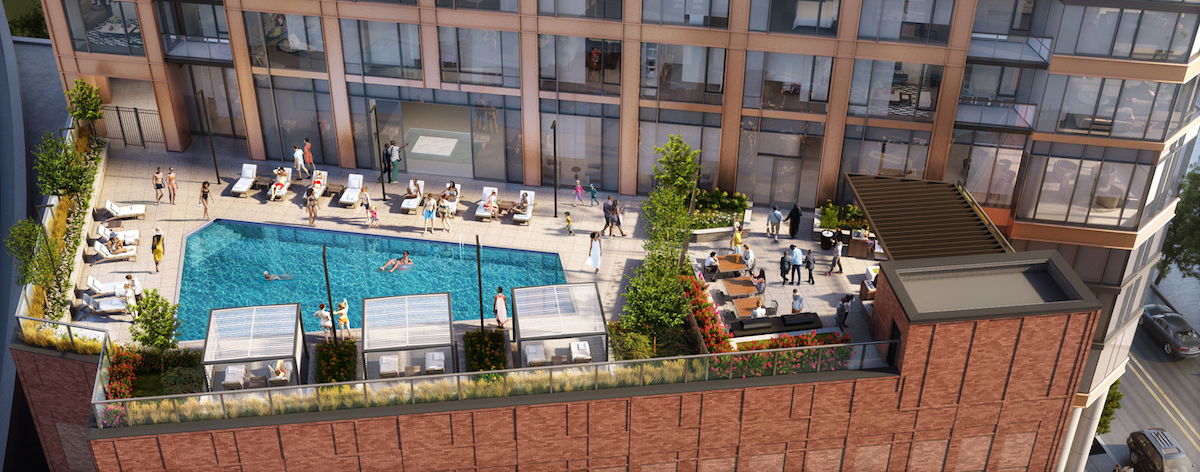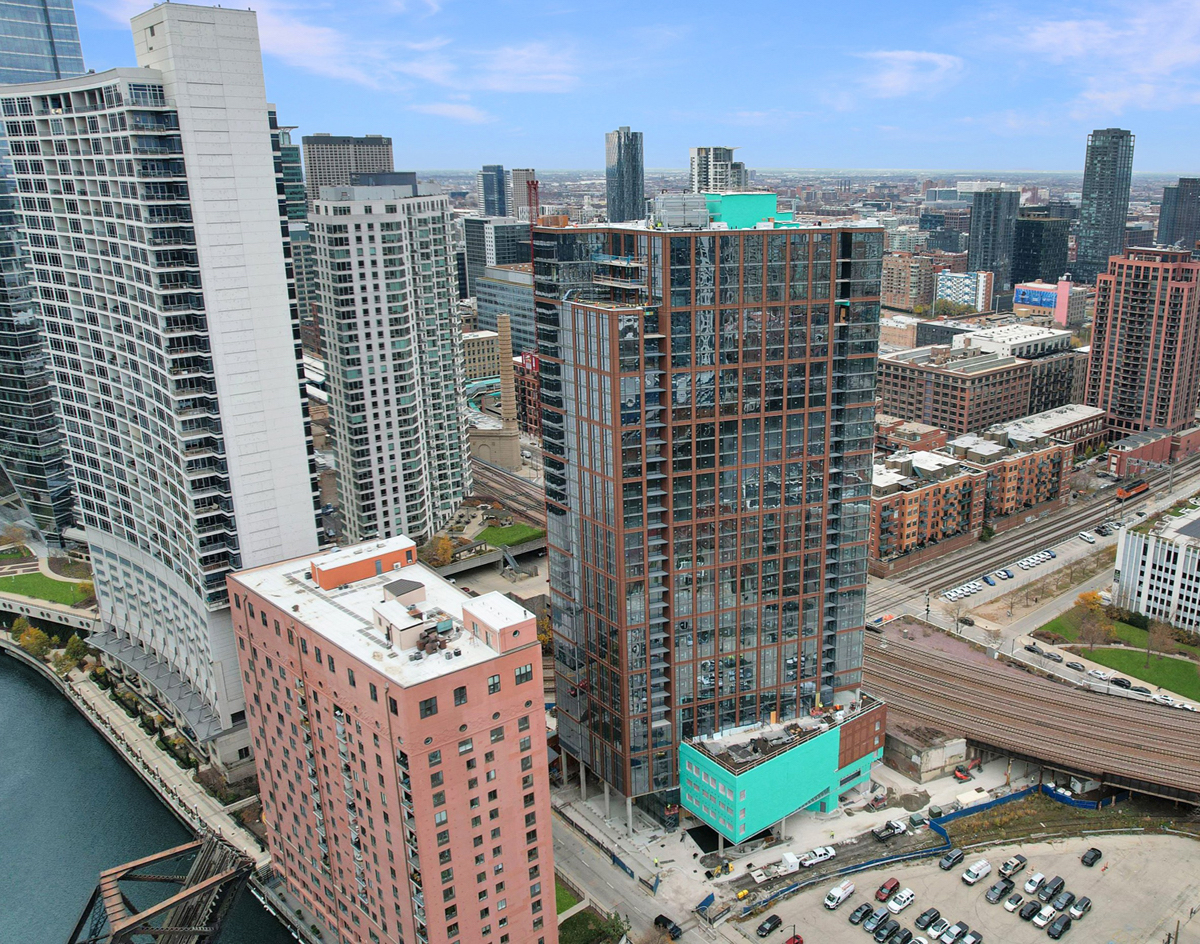Chicago-based Habitat, a leading U.S. multifamily developer and property manager, has started pre-leasing for Cassidy on Canal, a new 33-story, 343-unit Class A rental tower at 350 N. Canal St. in Chicago’s Fulton River District.
Cassidy on Canal features multiple apartment layouts across a mix of studio, one-, two-bedroom, and penthouse units, plus 1,313 sf of ground-floor retail, parking for 123 vehicles, and an outdoor dog run just northwest of the building.

The amenity package is highlighted by a 10,000-sf outdoor deck off the building’s fifth floor, with landscaped grounds, a pool, lounge seating, fire pits, grilling areas, cool weather heaters, and dining areas. The fitness center will offer residents practice studios, a game room, various club rooms, a coworking center, and a spa with sauna, steam, and whirlpool rooms.
PROXIMITY TO CHICAGO'S RIVERWALK
“Cassidy on Canal brings the best Chicago has to offer right to its doorstep with its proximity to the riverwalk and the numerous businesses, restaurants and entertainment options of the Loop, Fulton Market and River North areas,” said Habitat President Matt Fiascone. “Compared to the higher density of Fulton Market to the west, Cassidy is nestled in this protected sweet spot with the river to one side and train lines to the other, filling a void in the immediate neighborhood for a modern, highly amenitized rental option.”
FORMER HOME OF CASSIDY TIRE COMPANY
Rents will range from $2,550 to $5,660 for studios anbd one- and two-bedrooms. Penthouse units are expected togo for up to $10,810 per month.
Located on the west side of Canal Street between Kinzie and Fulton streets, the 350 N. Canal site was formerly home to the Cassidy Tire building. Designed by nationally recognized architecture firm Solomon Cordwell Buenz, the new 375-foot glass tower marks the latest luxury residential project for Habitat in the neighborhood.

Habitat delivered nearby developments like Kinzie Park with condominiums and townhomes in 2001, followed by the 43-story Kingsbury Plaza apartment tower in 2007 and the 43-story Class A rental Hubbard Place in 2013.
In 1980, Habitat completed East Bank Club, the city’s premier health club, which occupies more than two full city blocks at 500 N. Kingsbury St.
JOINT VENTURE WITH DIVERSIFIED REAL ESTATE CAPITAL
The joint venture partner on Cassidy on Canal is Diversified Real Estate Capital, LLC. James McHugh Construction Co. is the general contractor.
Cassidy on Canal is one of several major multifamily developments Habitat is currently leading across Chicago, including the equitable transit-oriented development 43 Green in Bronzeville; Ogden Commons in North Lawndale where Sinai Chicago has opened a One Lawndale Community Care & Surgery Center; and LeClaire Courts on the city’s South Side near Midway International Airport.
ABOUT HABITAT
Founded in 1971, Habitat is a full-service residential real estate company specializing in property management, acquisitions and development. One of the largest residential property developers and managers in the United States, with over $3 billion in assets and more than 16,000 units under management across six states, the company’s portfolio spans a range of property types, from mid- and high-rise condominium, apartment and adaptive reuse developments to senior and affordable housing communities. Headquartered in Chicago, the firm has more than 800 employees throughout the United States.
Related Stories
Industry Research | Jun 15, 2023
Exurbs and emerging suburbs having fastest population growth, says Cushman & Wakefield
Recently released county and metro-level population growth data by the U.S. Census Bureau shows that the fastest growing areas are found in exurbs and emerging suburbs.
Engineers | Jun 14, 2023
The high cost of low maintenance
Walter P Moore’s Javier Balma, PhD, PE, SE, and Webb Wright, PE, identify the primary causes of engineering failures, define proactive versus reactive maintenance, recognize the reasons for deferred maintenance, and identify the financial and safety risks related to deferred maintenance.
Mixed-Use | Jun 12, 2023
Goettsch Partners completes its largest China project to date: a mixed-used, five-tower complex
Chicago-based global architecture firm Goettsch Partners (GP) recently announced the completion of its largest project in China to date: the China Resources Qianhai Center, a mixed-use complex in the Qianhai district of Shenzhen. Developed by CR Land, the project includes five towers totaling almost 472,000 square meters (4.6 million sf).
Mixed-Use | Jun 6, 2023
Public-private partnerships crucial to central business district revitalization
Central Business Districts are under pressure to keep themselves relevant as they face competition from new, vibrant mixed-use neighborhoods emerging across the world’s largest cities.
Multifamily Housing | Jun 6, 2023
Minnesota expected to adopt building code that would cut energy use by 80%
Minnesota Gov. Tim Walz is expected to soon sign a bill that would change the state’s commercial building code so that new structures would use 80% less energy when compared to a 2004 baseline standard. The legislation aims for full implementation of the new code by 2036.
Student Housing | Jun 5, 2023
The power of student engagement: How on-campus student housing can increase enrollment
Studies have confirmed that students are more likely to graduate when they live on campus, particularly when the on-campus experience encourages student learning and engagement, writes Design Collaborative's Nathan Woods, AIA.
Multifamily Housing | Jun 1, 2023
Income-based electric bills spark debate on whether they would harm or hurt EV and heat pump adoption
Starting in 2024, the electric bills of most Californians could be based not only on how much power they use, but also on how much money they make. Those who have higher incomes would pay more; those with lower incomes would see their electric bills decline - a concept known as income-based electric bills.
Multifamily Housing | May 30, 2023
Boston’s new stretch code requires new multifamily structures to meet Passive House building requirements
Phius certifications are expected to become more common as states and cities boost green building standards. The City of Boston recently adopted Massachusetts’s so-called opt-in building code, a set of sustainability standards that goes beyond the standard state code.
Multifamily Housing | May 30, 2023
Milhaus, Gershman Partners, and Citimark close on $70 million multifamily development in Indy
Versa will bring 233 studio and one- and two-bedroom apartments to Indianapolis's $271 million, Class-A Broad Ripple Village development enterprise.
Multifamily Housing | May 23, 2023
One out of three office buildings in largest U.S. cities are suitable for residential conversion
Roughly one in three office buildings in the largest U.S. cities are well suited to be converted to multifamily residential properties, according to a study by global real estate firm Avison Young. Some 6,206 buildings across 10 U.S. cities present viable opportunities for conversion to residential use.


















